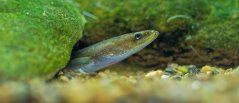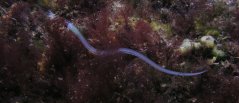
Longread
“It doesn't help our research that the eel keeps disappearing from view”
Besides obstacles during migration and pressure from fishing, eels also suffer from the pollution in Dutch inland waters. What are the effects of dioxins, PFAS and drug residues on eel health? For now, we have more questions than answers.
Alarms are regularly raised about the state of Dutch inland waters. People are also saying that water quality in the Netherlands will not meet the requirements of the European Water Framework Directive by 2027, potentially causing problems similar to the nitrogen crisis. Pesticides, PCBs, dioxins, heavy metals, microplastics, nitrogen, PFAS, oil, drug residues - the cocktail of pollution in our waters is obvious. Yet Edwin Foekema, ecotoxicologist and research associate in Experimental Ecology at Wageningen University & Research, is keen to add some subtle nuances. “The water today is so much cleaner than it was several decades ago. Awareness and efforts to curb pollution have increased considerably. Nevertheless, there are still substances in our water that do not belong there. And we need to remove as many of them as possible from that water.”
Foekema analyses the cocktail. With respect to heavy metals and microplastics, he does not expect significant effects on the eel population. “The concentrations in the body are too small to really become a factor.” What about nitrogen, which gets into the water through leaching from (artificial) manure? “Nitrogen is a nutrient, so it certainly has a major ecological impact, in the form of algal blooms, for example. But that doesn’t affect the eel too much. In the Netherlands, there used to be much more nitrogen and phosphorus in the water, and eel stocks were higher then.”
The concentration of toxins increases the higher up the food chain an animal is
It’s a different story for pollutants such as PCBs, dioxins and pesticides. The eel ingests these substances with its food: worms, crustaceans, fish. Foekema: “This is where a phenomenon called biomagnification comes into play: the concentration of toxins increases the higher up the food chain an animal is, for example a predator like the eel. The contaminants accumulate in the eel's body and dissolve in the fatty tissue.”

Toxic legacy
Eel is an oily fish and can therefore carry quite a lot of such fat-soluble toxins. This could become a problem when the eel embarks on its migration and relies on its fat reserves during the long journey across the Atlantic. Foekema: “The amount of fat decreases, increasing the concentration of toxins. The substances enter the bloodstream and roam through the body, and enter the eggs where they very probably affect the developing embryo’s and eventually the larvae.”
Foekema says ‘very probably', because we don't know for sure. Because we have never found eel eggs in the wild and there is no systematic research on toxins in wild larvae and glass eels. But through research involving other fish species, we do have strong evidence that this could happen. “I did research on sole, which showed that toxins are present in the eggs at the same concentration as in the mother fish. When the eggs hatch, the larvae initially obtain their nutrition from the yolk. But obviously, that yolk is also poisoned. The moment the larvae switch to self-caught food, we see increased mortality in the sole.”
Among other things, the toxins disrupt the vitamin A balance and the thyroid function, affecting metabolism, energy balance and growth. “That too can become a critical factor during migration. We can demonstrate all this in the lab in other species, but we don’t know whether this is a factor for wild eels. However, it is quite possible that the larvae of the eel, like those of the sole, inherit such a ‘toxic legacy’ via the eggs.''

Is eel still safe to eat when so much pollution collects in the fish? “In some areas, eel fishing is no longer allowed because pollution levels are too high. Think of areas around the Biesbosch and the Merwede. Ironically, if fewer contaminated eels are removed by fishing, their share in eel reproduction actually increases. Which could produce more ‘toxic eggs’.”
Tough eels
Another problem occurs with drug residues, which enter surface water with the domestic wastewater. “We know that hormones from the contraceptive pill can cause ‘feminisation’ in some fish species,” says Foekema. “Male fish that carry eggs, for example. Now, the eel is a strange creature: they don’t become sexually mature until they start migrating, which can take years. Moreover, the numbers of eels influence how many develop into males or females: at low densities, fewer males and more females develop. All this makes it difficult to determine whether hormones in the water also affect eels.”
Now, the eel is a strange creature: they don’t become sexually mature until they start migrating
Different effects can also be expected from other drug residues. Residues of antidepressants in the water could affect the eels' behaviour, causing them to act 'tough'. Foekema: “Under the influence of these susbtances, there is evidence that fish become less alert to predators, such as herons and cormorants. It can be speculated whether this also means that they are more likely to swim into a hydropower plant, for example, where they have a high risk of being cut. We just don't know.”
The same uncertainties apply with regard to PFAS, which can also accumulate in the eel's body. “These are substances that attach to proteins, not fat. It is known that they can affect the immune system and fat metabolism. How much this affects eels is still unclear.”
Critical circumstances
All in all, it is unclear, but plausible, that water pollution is affecting eel reproduction in some places. But are we also seeing eels becoming ill from it? “We know that eels can carry up to three different viruses, in varying compositions,” says Marc Engelsma, research associate at Wageningen Bioveterinary Research. “But we can’t yet say whether this is influenced by the level of pollution of the water they live in.”
The concern is that eels carrying so many substances in their bodies that do not belong there could be more susceptible to diseases and parasites. Engelsma: “To find out, you would need to take blood from eels at contaminated sites and compare it with that of eels from another area. But a viral infection can produce a wide variety of reactions, just like in humans. It will be difficult to draw any conclusions from that.”

Furthermore, you would need a huge number of eels to get a good sample. Engelsma usually works with farmed eels. “Because the reproduction cycle is not yet closed, glass eels from the wild are always involved. That means time and again, you also risk introducing new pathogens, such as the eel herpes virus.”Generally, such a virus only becomes a problem when a critical circumstance is added, such as stress. But eels in particular encounter such a critical circumstance sooner or later through migration. “That's obviously quite a drain on the animal. You don’t want to embark on such a journey sick. In fact, the eel is an extra burdened organism: because of that migration, but also, for example, because it is such an oily fish that can therefore store a lot of toxins in its body.”
Eels are so mobile, they can even move a short distance over dry land if necessary
So, to get a really good impression of the health of eels in the wild, several research challenges need to be overcome. Engelsma: “It’s difficult to link an eel to a particular contaminated area. They are so mobile, they can even move a short distance over dry land if necessary. In the ocean, we lose sight of them altogether. Because we can’t see which eels in the Sargasso Sea are producing which offspring, we can’t determine the effects of diseases and pollution on reproduction. It doesn't help our research that the eel keeps disappearing from view.”
Hidden cause
So, there’s plenty to explore and a lot of research questions. “We need to observe infected eels in swimming tunnels to see the extent to which diseases affect their condition,” says Engelsma. “I’d also like to improve virus detection. And: if we know which viruses no longer thrive at which temperature, then you can take that into account in nurseries in the water temperature.”
Foekema adds: “What I am curious about is whether the toxins cause subtle physical changes that make eels more vulnerable to certain adverse conditions, such as the effects of climate change. When fish die during a heatwave, we are quick to blame that heatwave. However, it could well be that the fish are less resistant to high temperatures due to other causes.”
With the Eel Project Group, Wageningen University & Research is ideally equipped to take up such research questions. Foekema: “Precisely because of the interdisciplinary set-up. So many interesting research questions and insights come together. For that, you just need to get two academics with different areas of expertise to talk to each other.”